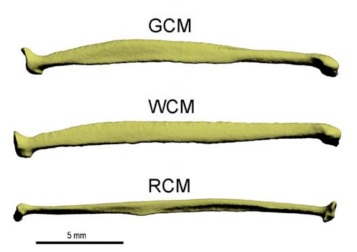
Manakins are a group of small passarine birds found across Central and South America. They are known for their often dramatic and noisy mating displays from males of the group, particularly movements of the wings. Wing snapping, when the male ‘claps’ the wings together behind him to produce a sharp noise, is observed in several species. The sound and speed of these snaps are impressive and have been a source of interest for biologists for several decades. Now, a selection of recent studies have shown that these remarkable birds have specialised adaptations to their wings to make these unusual displays possible. First, the bones in the equivalent of the forearm, the radius and ulna, can show distinctive shapes. The radius in some clapping species is broadened and flattened, creating a better and more robust percussional surface (see below). The distal tip of the bone is also entirely solid in some species, which is particularly unusual where birds are known to have lightweight, hollower bones to allow for flight. Another study has also shown specialised muscle tissue helps the birds to produce such rapid upward movement in the wing, with superfast contractions observed in the muscles necessary for mating displays but not in those only used in flight. As well as adapting their wings to flight, these are some of the first identified cases of biomechanical limb adaptations for specific mating displays.

Image – a club-winged manakin – courtesy and copyright of Dusan Brinkhuizen.
Glossary
Distal: At the end furthest from the main body, e.g. fingertips.
Passerine: Perching birds, can be identified by their toe arrangement (three forward, one back) which facilitates perching.
References:
Friscia, A., Sanin, G. D., Lindsay, W. R., Day, L. B., Schlinger, B. A., Tan, J. and Fuxjager, M. J. (2016), Adaptive evolution of a derived radius morphology in manakins (Aves, Pipridae) to support acrobatic display behavior. J. Morphol.
Fuxjager M. J., Goller F., Dirske A., Sanin G. D. and Garcia S. (2016), Select forelimb muscles have evolved superfast contractile speed to support acrobatic social displays. eLife 2016;5:e13544